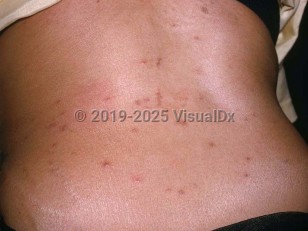While there are over 30 000 species of mites, there are only a few species that cause dermatitis in humans. Some of the most common mites that cause dermatitis are:
- Chiggers – Chigger is the common name for the larval form of the trombiculid mite. They are very common in the southern United States. When the larvae feed on humans, they secrete digestive enzymes into the skin that trigger an immune response in the host to produce intense pruritus.
- Scabies – Scabies is a parasitic infestation resulting when the mite Sarcoptes scabiei burrows into and lives just below the stratum corneum in the epidermis. Human scabies is transmitted most often via person-to-person contact. Most patients mount an intense hypersensitivity reaction resulting in a widespread and intensely pruritic skin eruption.
- Cheyletiella mites – Mites from the Cheyletiella species are parasites that live on cats, dogs, rabbits, and humans. These mites are nonburrowing; they live in the fully keratinized layer of the epidermis, feeding on tissue fluids and surface skin debris. The mites are commonly spread by direct contact from animals to humans, who may serve as an accidental host. Ask pet owners if symptoms started after acquiring a new pet.
- The relation of Demodex spp. (demodicosis) to human skin disease is uncertain, although sometimes anti-mite therapy may be appropriate.
- House dust mites – House dust mites (Dermatophagoides pteronyssinus and Dermatophagoides farinae) are a common source of allergens, causing asthma and other allergic symptoms such as perennial rhinitis. Dust mites do not bite; they feed on skin scales and other organic material. They prefer to live in bedrooms, mattresses, and carpets in warm, humid homes. House dust mites have been implicated as a trigger for atopic dermatitis. Several mechanisms have been proposed, including activation of keratinocytes by mite allergens, which induce production and secretion of proinflammatory cytokines.
- Rodent mites and bird mites – Rodent mites and bird mites are another common source of mite dermatitis. Rodent mites can be associated with household pets or with unwanted pests. Avian mites can sometimes be associated with household pet birds or with wild birds' nests that have been built near windows or in the eaves above human sleeping quarters.
- Straw and leaf itch mites and grain mites – Pyemotes mites can cause dermatitis in individuals exposed to grains or straw in agricultural environments. Those sleeping on straw mattresses can also be affected. Humans are accidental, temporary hosts. Outbreaks of extremely pruritic bites in Kansas, Missouri, Nebraska, Illinois, Oklahoma, Washington DC, and Texas have been associated with oak leaf gall mites (Pyemotes herfsi), also known as oak leaf itch mites.



 Patient Information for
Patient Information for 
